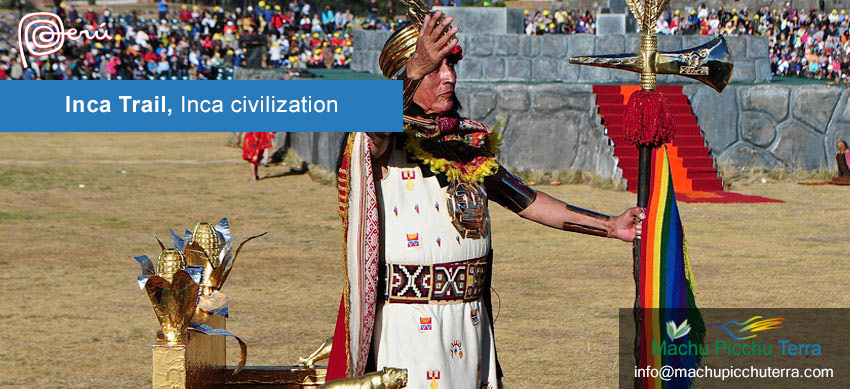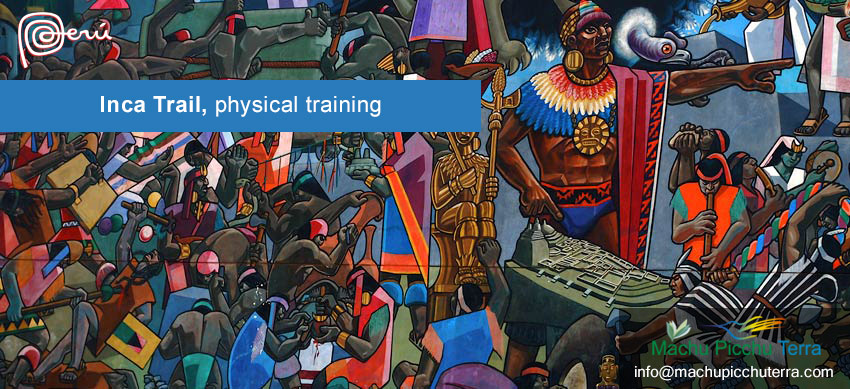
The Inca civilization was the largest in South America. It occupied part of the current countries of Peru, Bolivia, Ecuador, Colombia, Chile and Argentina. It developed between 1200 A.D. and 1533 A.D., approximately. For more than 3 centuries it developed an empire with important knowledge in architecture, ceramics, textiles, goldsmithing, and more. In addition, it consolidated itself as a conquering and strong state. Today several constructions are great tourist attractions such as Sacsayhuaman, Ollantaytambo, Choquequirao, Machu Picchu, and more.
The legendary origin of the Incas
In the oral tradition, two legends explain the origin of the Incas: a) the legend of the Ayar brothers and b) the legend of Manco Capac and Mama Ocllo.
The legend of the Ayar brothers – The Andean god ‘Wiracocha’ ordered his four sons to search for fertile lands in which to found a civilization. So, from the cave of Pacaritambo, the four Ayar brothers left: Ayar Cachi, Ayar Uchu, Ayar Auca and Ayar Manco. They were all accompanied by their wives. During the journey, conflicts arose among them. In the end, only Ayar Manco was left with the other wives. In Cusco, he plunged the rod into the ground, which indicated that it was fertile soil. Ayar Manco would become Manco Capac, the founder of the Inca nation.
The legend of Manco Capac and Mama Ocllo – Men lived in ignorance and sadness. Therefore, the sun god decided to send his son Manco Capac to Earth with his wife Mama Ocllo. Manco Capac took the golden scepter that symbolized the sun. His mission was to civilize the world to worship the sun. Manco Capac and Mama Ocllo emerged from the cold waters of Lake Titicaca. After a long walk, they arrived in Cusco where they sunk their scepter in the Huanacauri hill, as a sign of fertile land. There they settled, civilizing men and women and founding the Inca nation.
The historical origin
Both legends and historical sources indicate that the Incas came from the Altiplano region (border between Peru and Bolivia).
Due to the threat of the Aymara and Colla peoples who lived there, the ethnic groups led by Manco Capac had to emigrate in search of fertile lands where they could settle. So they traveled south where they stayed for a while in places like Pallata and Huanacancha.
After a long route, they arrived at the city of Cusco where they managed to ally with the Quechua people who inhabited the place. Manco Capac established a more civilized society. Gradually he expanded the limits of his domains. Thus was born the Inca society.
The rise of the Inca empire
The Incas settled in Cusco from 1,200 AD. In this first stage of their history, the Inca society was called ‘Curacazgo del Cusco’ because they did not achieve a great expansion of their territory. During the first years of existence, the Incas had constant conflicts with neighboring ayllus such as the Ayamarcas or the Pinaguas.
During the so-called ‘Curacazgo del Cusco’ the Incas had eight rulers: Manco Capac, Sinchi Roca, Lloque Yupanqui, Mayta Capac, Capac Yupanqui, Inca Roca, Yahuar Huacac and Huiracocha Inca.
In the beginning, the Incas did not build significant constructions. The timid expansion they achieved was always threatened by the presence of the Chancas, their fiercest enemies. During the government of Huiracocha (1370 – 1430) the Chancas threatened to invade Cusco. The result of this war meant the final expansion or the disappearance of the Inca civilization.
Pachacutec, Machu Picchu and the Qhapac Ñan
Pachacutec (1418 – 1471) was the leader of the Incas during the wars against the Chancas. He was the son of Huiracocha Inca who abandoned Cusco after the Chanca threat. The surprise Inca victory forced the Inca to crown Pachacutec as the new ruler.
Pachacutec was a great statesman. After the Chanca victory, he significantly expanded the territories. Likewise, he formulated laws for the better organization of the Inca society. He ordered the construction of important citadels such as Machu Picchu. He linked the flourishing territory with hundreds of kilometers of Inca roads (the Qhapac Ñan). Finally, he founded the Inca empire, also called Tahuantinsuyo.
Pachacutec’s successor was Túpac Yupanqui (1411 – 1493) who continued the expansion of the Inca empire. The same happened with Huayna Capac (1468 – 1524), his son and successor, who achieved the maximum expansion of the empire. This reached more than 3,000 square kilometers. To the north it reached the Ancasmayo River in Colombia, and to the south the Maule River in Chile (and Tucumán in Argentina). To the east, it timidly entered the Amazon jungle. To the west, it bordered the Pacific Ocean.
The civil war
The sons of Huayna Capac confronted each other for the control of the throne causing the so-called “Inca Civil War”. Huáscar (1491 – 1533) proclaimed himself Inca and settled in the city of Cuzco. His brother Atahualpa (1500 – 1533) gathered a powerful army in the city of Quito from where he tried to seize power.
The battles were numerous with deaths on both sides. It is estimated that between 60,000 to 1 million died. Finally, Huáscar was captured and ordered to kill by Atahualpa.
After the victory, Atahualpa is informed of some strange white and bearded men in the town of Cajamarca. There he went with his retinue without knowing that he would be captured. It was 1532 and the Spaniards had already set foot on the land of the Inca empire.
The fall of the empire
During the Inca Civil War, the Spaniards arrived in Cajamarca, under the leadership of Francisco Pizarro (1478 – 1541). Despite Huáscar’s defeat, the Inca empire remained divided into southern (Cusco) and northern (Quito) sides. The Spaniards took one side or the other according to their convenience.
The Spaniards, supported by peoples subdued by the Incas such as the Cañaris, captured Atahualpa in Cajamarca and forced him to pay a formidable treasure for his ransom. Even so, they assassinated him. Before advancing to Cusco, they obtained alliances with the Cusco nobility. They arrived in the city of Cusco in 1533.
The Inca nobility did not take long to realize the conquering intentions of the Spaniards. However, it was already too late. Francisco Pizarro had a very large Indian army at his disposal.
Manco Inca, brother of Huascar and Atahualpa, left Cusco with an army and settled in Vilcabamba, a town in the thick jungle. From there he declared war on the Spaniards. The battles lasted approximately 40 years. Finally, the Spaniards assassinated Tupac Amaru I in 1572. With the death of the last rebel Inca of Vilcabamba, the Inca power ended.

The knowledge of the Incas
During almost four centuries of existence, the Incas reached a high level of development in ceramics, textiles, goldsmithing, and, above all, architecture. Their cities and temples were made of stone with great perfection. A clear example of their ability to mold the rock at will is Sacsayhuaman, Coricancha, or Machu Picchu.
As for their religion, the Incas were polytheists. They were also pantheists because they worshipped everything natural. Their main god was the sun. They also worshipped the moon, the stars, water, mountains, etc. They built their temples relating them to the movement of the stars, giving them not only an architectural but also a religious and spiritual function.
Politically the ‘Inca Sapa’, or ‘Son of the Sun’, was the maximum chief, almost a god for the people. He led the empire with a sophisticated system of government, based on the redistribution of labor. The registration of labor and accounting of products was recorded with a system of knotted strings called ‘quipus’.
Its main temples and cities were connected by an immense network of Inca roads that still survive today in several sections. These were called ‘Qhapac Ñan’ and reached more than 30 thousand kilometers throughout the empire. In addition, the Incas established a system of ‘chasquis’, who ran fast, carrying messages and merchandise throughout the Inca territory.
By Inca Trail Machu Picchu - Last updated, 22-08-2024
Interested in the Inca Trail? Know more about Information Inca Trail!
- Inca Trail: prices and discounts
- Inca Trail hike as a therapy to heal body and soul
- What is it like to camp overnight on the Inca Trail?
- Online availability Inca Trail to Machu Picchu 2025
- Sustainability tips for the Inca Trail
- How to get to Ollantaytambo?
